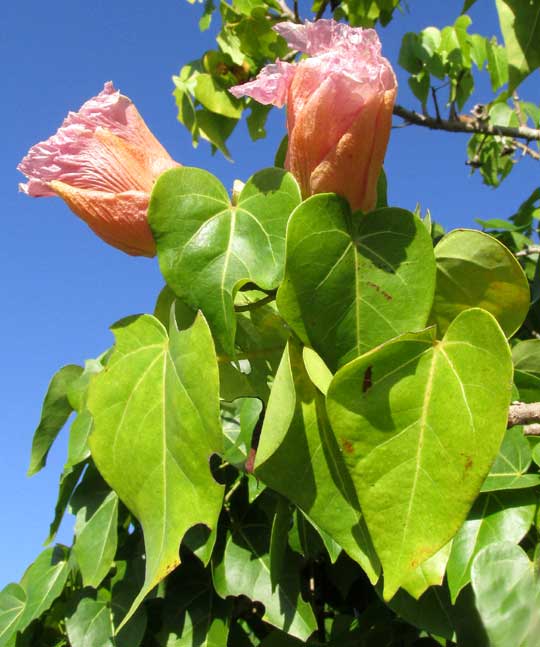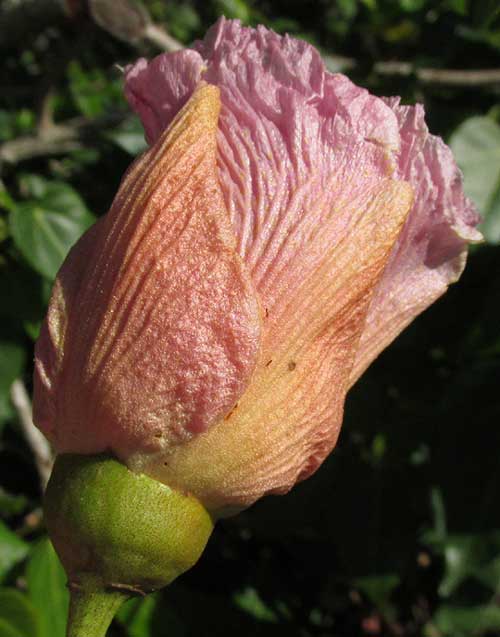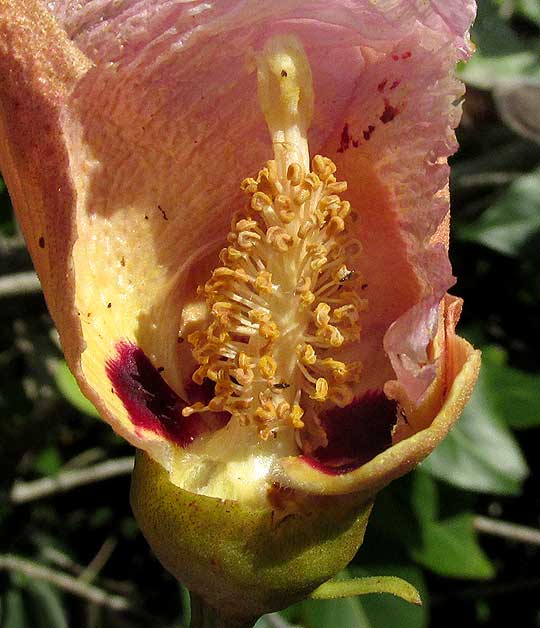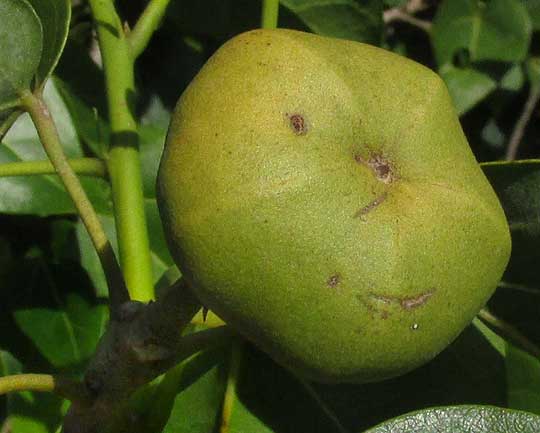Excerpts from Jim Conrad's
Naturalist Newsletter
from the November 30, 2014 Newsletter issued from Río Lagartos, on the Yucatan Peninsula's northern coast (~N21.60°, ~W88.16°), Yucatán state, MÉXICO
PORTIA TREE
Beside the tall, white wall surrounding Río Lagartos's cemetery there stands a well formed tree about 15ft tall (4.5m), with shiny, heart-shaped leaves about three inches long, and nowadays handsomely adorned with cup-shaped flowers also about three inches long, as shown below:

A side-view of one of the pretty flowers is shown below:

An interesting field mark to notice is that the smaller, outermost "petals" are actually calyx lobes, or sepals, modified to look like petals. One way you know they're not real petals is that their color and texture don't exactly match those of the corolla within the ring of lobes, but the main indication is that the lobes are weakly attached along a fracture line to an otherwise normal, green, bowl-shaped calyx below the petal-like lobes. If you break open a flower, you can see all this as well as other important features, as shown below:

All those stamens united at their bases into a cylinder surrounding the ovary's style, and with thick, yellowish stigmas atop a white style emerging from the stamen-bearing cylinder tells us instantly that here once again we're dealing with the huge Hibiscus or Mallow Family, the Malvaceae. However, the calyx with its petal-like sepals that easily break off the green bottom suggest that the tree isn't a hibiscus itself, and the rounded, leathery-skinned fruits are very unlike hibiscus fruits. You can see the fruits, which don't split open at maturity, and appear adapted for dispersing its seeds by dropping into water and floating away. You can see a green one below:

With such an un-hibiscus-looking fruit it was easy to identify our cemetery tree as what's often called the Portia Tree. It's THESPESIA POPULNEA, so generally planted and often escaped into the wild in tropical regions worldwide that it's unclear where it originated, though some suggest India. It's common in coastal strand vegetation throughout the Old World tropics and has escaped in much of tropical America, including southern Florida where it's regarded as an invasive. It must grow wild here, too, because it's listed in the inventory of plants of the Ría Lagartos Biosphere Reserve.
Something I learned only by reading about it is that when its flowers open they are yellow, only turning pinkish like those in our pictures after they are pollinated. The Tree Cotton we grew back at Chichén Itzá did the same thing. In fact, Portia Tree is very closely related to the cotton plant
One reason the Portia Tree is planted so widely is because it's pretty. Another is that it's useful. Its wood is excellent for making small articles such as musical instruments, is multicolored and resistant to termites, rope can be made from its fibrous bark, yellow dye can be extracted from its flowers and fruits, plus Portia Trees provide good tree and make a fine windbreak. The flower buds and leaves can be eaten raw or cooked. Medicinally, the seeds are applied to scabies and other skin diseases, and are rubbed onto swollen joints, and a tonic is brewed from its roots. Yellowish juice from young fruits is used to treat insect bites, gonorrhea, ringworm, and migraine headache. In fact, so many medicinal uses are listed for it that you just wonder about it.
Becoming introduced to such a tree for the first time is a genuine pleasure. Maybe you can share in my feeling of discovering something worthy by including an evocative picture of the entrance to the cemetery beside which our Portia Tree was standing, seen below:

from the May 10, 2015 Newsletter issued from Río Lagartos, on the Yucatan Peninsula's northern coast (~N21.60°, ~W88.16°), Yucatán state, MÉXICO
PORTIA TREE FRUITS
Since profiling the Portia Tree last November, I've found that not only is the tree planted in Río Lagartos but also it commonly grows as a weed tree Río Lagartos and out in the Biosphere. Nowadays our Portia Trees are fruiting, as shown:

Though Portia Trees' flowers are very similar to hibiscus blossoms, you can see that the blackish, puckery fruits are weird looking things not at all suggestive of the Hibiscus Family. The fruits are lightweight but so hard that a thumbnail hardly can scratch off a bit of skin, and they can hardly be cracked open with bare hands. It's thought that Portia Tree fruits are adapted for dissemination by floating. Studies show that seeds can germinate after a year of the fruit floating in seawater.